Summary of Cimabue
As the foremost Tuscan painter and mosaicist of his generation, Cimabue took the lead role in the transition from the medieval to modern era of Italian art. In a subtle, yet unmistakable, break with the flat schematic methods of the Byzantine painters, Cimabue's work pointed to the potential for pictorial three dimensions and more naturalistic representations, effectively preparing the ground for the full rebirth of 14th-century Florentine art. Cimabue put down his own marker on the timeline of art history and is today celebrated for his influence on the next generation of Italian artists; most notably his apprentice Giotto, who overtook his mentor to become the first true Renaissance Master.
Accomplishments
- Although history has tended to relegate him to a supporting role in the rise of his "superstar" protégé Giotto, modern scholars have secured Cimabue's substantial legacy solely on the quality of his own paintings and mosaics. It was Cimabue, after all, who had the imagination to see the possibility for decorative Christian art to move beyond icon painting and to bring an earthlier, more human centered, element to devotional altarpieces and frescoes.
- Thirteenth century Italian artists painted in the flat (two-dimensional) iconographic Eastern Christian Byzantine style. Cimabue's compositions start to suggest the potential for greater pictorial depth. The curved steps on which his Virgin's throne sits, for example, give the illusion that she occupies a real space.
- Cimabue was admired for his ability to create emotional expression. In his early altarpiece The Crucifixion (c.1270), for instance, his depiction of Christ's body is rendered through shading on the legs, torso, arms, and underarms imbuing them with a flesh-like plasticity. It signified a departure from the rigid Byzantine figures of Christ on the cross and anticipated the more expressive and naturalistic representations that so distinguished devotional art of the Renaissance period.
- It is known that Cimabue was of a tempestuous nature, and he would abandon or destroy works that failed to reach his own exacting standards or those of his critics. This artistic "insolence" distinguished Cimabue from the anonymous painters - or artisans - of the Middle Ages. His modern attitude, or "personality", helped earn him the distinction of being the first entry in Giorgio Vasari's seminal anthology, The Lives of the Most Excellent Painters, Sculptors and Architects (1550), and positioned him thus as the very first genius in Vasari's story of Renaissance art.
The Life of Cimabue
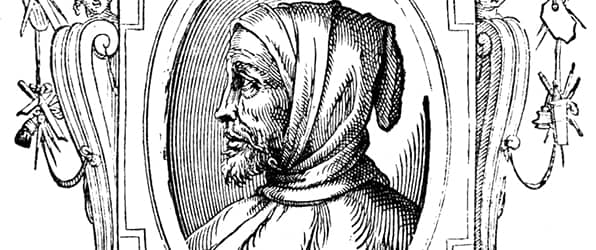
Upholding the view that he was so much more than Giotto's teacher, Art historian Eugenio Battisti wrote, "Everyone had to take into account the enormous range of stylistic and human problems that Cimabue was the first to infuse into paintings [...] he emerges not as a precursor but the nucleus, the compendium of almost all Italian art".
Important Art by Cimabue
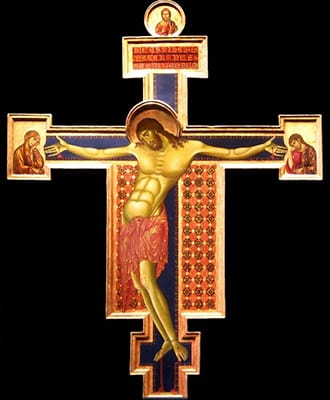
The Crucifixion
One of Cimabue's earliest works, this large size crucifix was commissioned by the Dominican order for the Basilica of San Domenico in Arezzo. It depicts Christ on the cross at the height of his suffering and in the throes of death. Christ's body is contorted and slumped turning to the left, his eyes are nearly closed, and his brow is furrowed, conveying to the viewer the agony of his crucifixion. The work is grandiose and richly decorated. Details such as Christ's red loincloth, accentuated by highlights of gold, create the appearance of a soft and supple fabric that gently falls over the tortured body. Two mourning figures, the Virgin Mary and St John the Evangelist, are presented as half-figures on the horizontal axis of the cross. On the top of the crucifix there is a small panel of the Blessing Christ, painted in accordance with the conventions of Byzantine art.
Cimabue was influenced by the works of his predecessors, Florentine painter Coppo di Marcovaldo and Pisan painter Giunta Pisano. The design of the Arezzo crucifix is closest to Pisano's crucifix commissioned by the Dominican order for their principal church in Bologna. However, although Cimabue preserves the schematic appearance of the muscles, arms and abdomen, he further develops the corporeal qualities of Christ's flesh. His strategic use of shade on the legs, torso, arms, and underarms add to the plasticity of the body. Cimabue's crucifix signified thus a departure from the stoical figures of Christ on the cross and anticipates the more expressive and naturalistic representations associated with the Renaissance period.
Tempera and gold on wood - Basilica of San Domenico, Arezzo
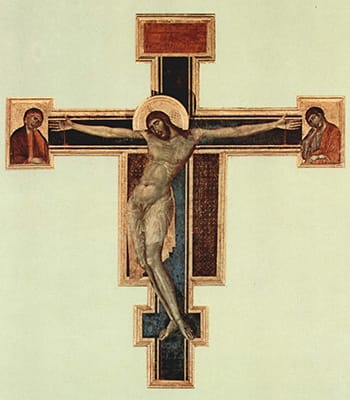
The Crucifixion
Cimabue painted the crucifix for the Franciscan order at the Basilica di Santa Croce in Florence. Although the work again reflects Byzantine iconography, the monumental crucifix also demonstrates Cimabue's gradual departure from tradition. But despite the compositional similarity to the Arezzo crucifix, Cimabue here creates a more expressive representation of Christ which invites the viewer to empathize more fully with Christ's human suffering.
Historian Luciano Bellosi summarized two significant innovations in the treatment of Christ's body which distinguish this work from the earlier crucifix in Arezzo. The first is the use of green that creates the effect of dead flesh; the second is the artist's deviation from the schematized rendering of the muscles. Christ's body is no longer composed of rigid forms, Cimabue's masterful use of shading creates flowing shapes that result in a much more naturalistic appearance of the muscles and skin than one would find in Byzantine art. Unfortunately, the work was severely damaged during the flood that hit Florence in 1966, and despite conservation efforts, it remains in poor condition.
Tempera and gold on wood - Basilica di Santa Croce, Florence
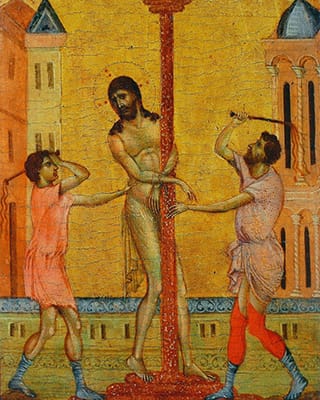
The Flagellation of Christ
This panel depicts one of the key moments of the Passion. Prior to being condemned to death by crucifixion, Christ was tied to a column and whipped by Roman soldiers. While Christ and his punishers occupy the foreground, the background is dominated by gold (reflecting his Byzantine heritage), with the two towers representing the architecture of ancient Jerusalem. The placement of the figures and the architectural elements demonstrate Cimabue's experimentation with illusionistic spatial effects, even if he would never fully master creating the full illusion of perspective.
This is the only work by Cimabue in a public collection in the United States. It was purchased for the Frick collection in 1950 on the initiative of Henry Clay Frick's daughter, Helen Clay Frick. At the time of the acquisition, scholars debated whether this work was painted by Cimabue or Duccio. Only a half a century later was the debate settled with the discovery of a panel, The Virgin and Child Enthroned with Two Angels, now at London's National Gallery, where obvious stylistic comparisons (size, materials, red borders, incised margins, etc.) firmly attributed The Flagellation of Christ to the hand of Cimabue. Technical examinations also revealed that the National Gallery panel and The Flagellation of Christ were once a part of a larger work, most likely an altarpiece. In 2019, Christ Mocked, a third panel of this larger work was recovered (and acquired by a private collector).
Collectively, the three panels share characteristics with Cimabue's fresco cycles at the Basilica of Saint Francis of Assisi. The arrangement of the architectural elements in The Flagellation of Christ being comparable to many of the frescoes in Assisi; especially the Saint Peter cycle and the Evangelist portraits in the vault of the Upper Church.
Tempera on poplar panel - The Frick Collection
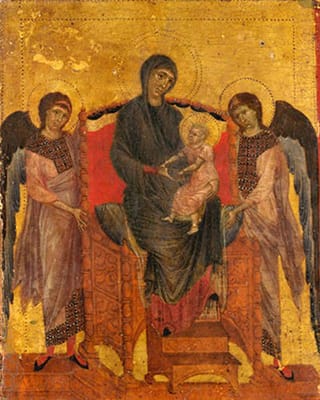
The Virgin and Child with Two Angels
This small panel portrays the Virgin and Child seated on a wooden throne and presented to the viewer by the two angels. The image corresponds with the Byzantine prototype of the Virgin enthroned with the archangels Michael and Gabriel. The rich decorations on the angel's garments resemble the loros: embroidered and jewel studded fabric that was part of the ceremonial imperial costume of the Byzantine empire. In this way Cimabue formed a visual link between earthly rulers and the Kingdom of Heaven.
Although the panel is still rooted in Byzantine tradition, Cimabue altered the image in significant ways, creating a more naturalistic and impassioned representation for the religious worshipper. The throne is a three-dimensional structure that gives the space a sense of depth, while the pillow on the throne seems to curl under the weight of the Virgin and Christ, enhancing the physicality of the figures. Furthermore, there is a closeness and intimacy between infant Christ and the Virgin illustrated by the affectionate gesture of his grabbing of her hand. These innovations were influential on the next generation of Italian artists (notably Giotto and Duccio).
Unlike Cimabue's monumental depictions of the Virgin and Child, this panel provides insight into how the artist transformed Byzantine models on a smaller scale. After the discovery of the panel in 2000 (and its attribution to Cimabue) technical examination proved that together with The Flagellation of Christ and Christ Mocked (discovered in 2019), it formed part of a small altarpiece which was likely a private devotional object.
National Gallery, London - Tempera on poplar wood

Christ Mocked
In 2019, Cimabue made headlines when an extraordinary discovery was made in an elderly woman's kitchen in Northern France. A small icon above her hotplate was in fact a panel painting by Cimabue dating from around 1280. As historian and auctioneer Kay Carson observed, "It was discovered quite by chance, thanks to an auctioneer who was at the house in Compiègne, France, to value furniture". The scene, which depicts the mocking of Christ prior to his crucifixion, is set against a gold backdrop, with architectural elements that represent the city of Jerusalem. Cimabue employs an inverted perspective in the architectural elements, following many conventions of art at the time.
Christ is placed at the center of the composition, encircled by threatening figures of young and old men with swords and sticks. The dense composition of intertwining arms and legs creates multiple focal points that ultimately lead the viewer's gaze toward the suffering figure of Christ. Cimabue contrasts Christ's calm and mournful expression with the grimacing and hateful faces of the angry mob. Christ also appears to be standing above the crowd, a symbol of his moral superiority. Italian art historian Andrea De Marchi emphasized the importance of this newly discovered panel: "for the first time, we have one of Cimabue's greatest qualities, that of choral narration, of the crowding of figures - so evident in his frescoes at Assisi - in a small-scale panel painting". What has become known as "the Compiègne panel" sold for a record price of £20.7 million at auction.
Tempera and gold leaf on poplar panel - Private Collection
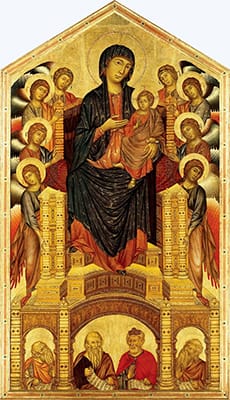
Virgin and Child Enthroned, and Prophets (Santa Trinita Maestà)
Cimabue painted several versions of the Virgin and Child enthroned (also known the Maestà ("majesty")). The image is set against a gold background that symbolizes the divine light and suggests an otherworldly dimension in which the scene occurs. Seated on a lavish throne, the Virgin holds Christ on her lap, with eight angels holding up the throne. Their halos are decorated using punches (tools used to create indentations) for gemstones. The Virgin gestures toward her son with her right hand thus following the Byzantine model of the Virgin Hodegetria, indicating that Christ will lead the way to salvation.
Cimabue remains influenced by Byzantine models, but his adaptation of these models introduced novel elements. For instance, the gilding of the Virgin's robe is achieved by using a traditional Byzantine technique called agèmina: the inlaying of different metals into one another. Yet, the treatment of the robe also deviates from Byzantine tradition. It drapes loosely over the body with its delicate folds and reveals more of the Virgin's undergarment. The Virgin's veil falls vertically from the top of the head, creating a sense of movement caused by the folds. The throne, meanwhile, is incredibly intricate, covered as it is with wooden carvings and gems. Indeed, an important difference emerges in the presentation of the throne: it is no longer drawn sideways as in other depictions of the Maestà by Cimabue. Instead, it is seen from a frontal position, following the rules of centralized perspective, which were adopted by Giotto, Duccio and other 14th century artists. The rendering of the throne, especially the carefully carved steps, enhance the spatial depth of the composition.
But it is perhaps the base that has caused most interest amongst historians. Dr. Holly Flora writes: "Founded in the eleventh century by the Florentine knight Giovanni Gualberto, the Vallombrosans [monastic religious order] sought to bring monastic life back in line with the values of Saint Benedict of Nursia". The members of the Benedictines order celebrated the Old Testament prophets Jeremiah, Abraham, David and Isaiah in their literary and devotional traditions. Flora notes that "Cimabue's placement of David [identified through the bright red mantle and crown] and the other figures at the base of Mary's throne was a completely original visual element and may have been part of the artist's efforts to create a new spin on the Maestà in celebration of the Vallombrosans, creating their own signature' Madonna" while adding that the "spectacular and innovative Maestà that Cimabue created would certainly have brought new attention and prestige to the Vallombrosans at Santa Trinita".
Tempera on panel - The Uffizi Gallery, Florence
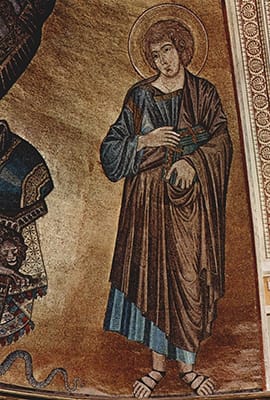
Saint John the Evangelist (detail)
Created for the apse of the Pisa Cathedral, the mosaic of Saint John the Evangelist is the only chronicled work by Cimabue. Documentation shows that Cimabue was working on the mosaic in Pisa between September 1301, and February 1302. It is likely the last work he completed before his death. The mosaic in its entirety depicts the Enthroned God at the center of the composition, with the Madonna on his left and Saint John the Evangelist on his right. Several artists contributed to the mosaic (an artist named Francesco executed the Enthroned God, Cimabue worked on the figure of Saint John, while the figure of the Madonna was completed by Vincino da Pistoia).
While Cimabue is primarily known as a painter, he was evidently highly skilled in mosaic work, so much so that the mosaic almost appears as one of his painted panels. The colors are not rigidly divided, instead the placement of tiles creates a gradient effect. The evolved shading is most evident in the delicate treatment of the skin tones and the elaborate robe. The complex folds of the drapery with their clean and neat edges give the impression of rustling silk.
The mosaic shares attributes with Cimabue's mature paintings. The positioning of Saint John's hands holding a book, for instance, resembles the hands of Saint Francis in the fresco Virgin and Child with Angels and Saint Francis of the Lower Basilica in Assisi. Elements such as the Saint's voluminous hair are also characteristic of the artist's mature style. Art historian, Luciano Bellosi also noted how "the inclination of the head, which is melancholy without any sense of sulking, compares favorably most of all with the Santa Trinita Madonna".
Pisa Cathedral, Pisa - Mosaic
Biography of Cimabue
Childhood
Very little official documentation is available about the life of the 13th century Italian master, christened Bencivieni di Pepo, but better known by the name Cimabue. The earliest account of Cimabue's life was penned by Giorgio Vasari in his famous work The Lives of the Most Excellent Painters, Sculptors and Architects (1550). Vasari, whose biographic anthology effectively established him as the modern world's first art historian, opened his book in fact with Cimabue's biography.
According to Vasari, Cimabue was born in the year 1240 in Florence to a family of noblemen. His father sent him to a relative to learn to read and write but the boy reportedly showed little interest in his studies. He was then sent to the Santa Maria Novella convent school where Cimabue took to sketching figures and animals on the pages of his textbooks. When Greek artists arrived in Florence to decorate the convent church, Cimabue's parents gave him permission to study their work. By Vasari's account, Cimabue "surpassed by a long way those Greek painters".
Because it is known that Vasari freely embellished the story of his artists' lives, one should remain circumspect when examining his account of Cimabue's life. As art historian J. White writes, according to Vasari "Cimabue becomes, with his Florentine successor [Giotto], one of the first heroes, in the battle fought to escape the abyss of medieval barbarism, which follows the great deeds of Antiquity and precedes the even more marvellous conquests of the Renaissance". The art critic Johnathan Jones adds that Vasari even "falsely claimed [Cimabue] painted the Rucellai Madonna, a famous altarpiece in the church of Santa Maria Novella in Florence that is credited today to the Sienese artist Duccio. This wasn't an innocent mistake: Vasari was a court artist to the Medici and wanted to credit Florence with starting the Renaissance".
Early Training and Work
In Vasari's account, Cimabue was trained by Greek Byzantine artists who resided in Florence throughout the thirteenth century. However, contemporary art historians believe that now seems highly unlikely and that story probably served Vasari's wish to account for Cimabue's genius and to heighten the impoverished state of Italy's art prior to the Florentine's intervention. There are no other confirmed facts about Cimabue's early training. However, his early work suggests that he was influenced by Pisan painter Giunta Pisano and Florentine painter Coppo di Marcovaldo. Given the strong stylistic similarities, chronological and geographical circumstances, it is also possible that the young Cimabue served for a period as Coppo's apprentice.
Because only a small number of works can be attributed to Cimabue, and because there is so little documentation that cites the artist explicitly by name, the dates of most of his works remain speculative. Nevertheless, it is generally accepted that one of his early important works was a wooden crucifix for the Basilica of San Domenico in Arezzo which he created around 1270. It demonstrates his attempt to advance the Byzantine style both in technique and in his more humanistic vision of religious art. Cimabue's Christ is not therefore triumphant or defiant, but closer to a human figure weighed down by suffering and sin.
Mature Period
White states, "[Cimabue] was certainly an adult and an independent teacher when, on 18 June 1272 in Rome, he was mentioned as a witness in a notarial document as 'Cimabove Pictore de Florencia'". Sadly, not much else is known about his activities in Rome. But the document indicates that Cimabue (a "painter from Florence") was already an accomplished artist and by now in his early thirties. Furthermore, the list of witnesses in the document reveals that he was well-connected and in the company of powerful figures in the Church.
On his return to Florence (from Rome), Cimabue created the large wooden Crucifix for the Basilica di Santa Croce (which was badly damaged in the devasting Arno River flood of 1966). Historian Kay Carson says of the work, "The realistic slump of Christ's body, together with the strain of his outstretched arms, graphically depicts human suffering, far removed from the stylised, expressionless iconography of the time. Moreover, the folds of cloth and the way in which the hands and feet protrude beyond the cross provide an albeit basic, three-dimensional effect".
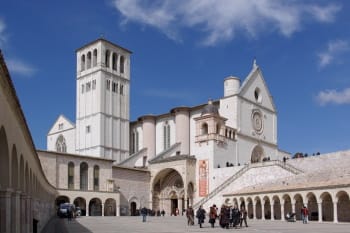
One of Cimabue's most important undertakings around this time was the fresco cycle created for the Basilica of Saint Francesco in Assisi. The date of the frescos are still disputed among scholars but they were probably painted under the patronage of Pope Nicolas III between 1277 and 1280 (or less likely under the patronage of Pope Nicholas after 1290). The Basilica of Saint Francesco consists of two churches. The lower Romanesque church dates from around 1230, while the upper Gothic church opened in 1253. The Cimabue fresco cycle occupy the Upper Church (Giotto decorated the lower area) with The Four Evangelists in the vault of the presbytery; Stories of the Virgin in the choir; his Apocalyptic Scenes and Crucifixion occupy the northern arm of transept; and the Healing of the Lame the southern arm.
The large-scale project required a workshop that employed numerous assistants who supported the artist with this ambitious task. Cimabue worked alongside Jacopo Torriti and Pietro Cavallini, Roman artists who were also interested in exploring more humanistic forms of icon painting. Indeed, White observes that history has tended to "overlook or not realize how mobile artists were - moving from place to place across the unstable political boundaries of the time, often taking their workshops with them and changing citizenship when circumstances [demanded]".
The project earned high praise from Vasari: "[Cimabue] demonstrated in this work greater powers of invention along with a beautiful style in the pose of a Madonna". An example of this is the reworking of the Virgin's robe, namely the veil that falls vertically from the top of the head giving the image a more natural appearance. These innovations were adapted by other artists in Cimabue's circle as well as younger artists (including Giotto and Duccio). In fact, because of its similarities to Duccio's Rucellai Madonna, it is reasonable to assume that the two artists worked closely together or were at least acquainted professionally. It is also evident the Cimabue was influenced by (and indeed an influence on) Dietisalvi di Speme, a painter, and probably his closest rival, working in the Siena region (76km south of Florence).
The origins and date of his adopted name is something of a mystery: "cima" translates as "top", while "bue" refers to an ox or other bovine creature. John R. Spencer, Professor of Art, Duke University, Durham, suggests that "Cimabue's character may be reflected in his name, which can perhaps best be translated as 'bullheaded'". Spencer cites "an anonymous commentator in a work on Dante written in 1333-34" that described Cimabue as "so proud and demanding that if others found fault with his work, or if he found something displeasing in it himself, he would destroy the work, no matter how valuable". In Italian the nickname "bullhead" also applied to "one who crushes the views of others" and this tallies with the biographical picture of an artist whose hubris made him contemptuous of his critics and distractors.
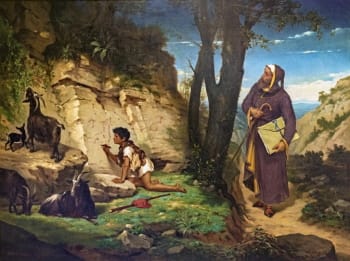
There are two famous myths regarding Cimabue and Giotto's relationship. The Florentine artist, Lorenzo Ghiberti recounted a story of how Cimabue met Giotto as a small boy who was drawing a sheep from life. So impressed was he by his talent, Cimabue took on the young boy as his apprentice. This narrative has reverberated down the centuries and was also visualized by the Pre-Raphaelite painter Frederic Leighton. Another account describes how Giotto fooled his teacher by painting a fly so convincingly that Cimabue repeatedly tried to brush it off.
Vasari attributed Cimabue's haughty and proud character trait to his bitterness over Giotto's rise to fame. Indeed, Cimabue is marked in history as the teacher of the great Early Renaissance painter (Giotto). The idea of Cimabue being" overtaken" by Giotto was fixed, however, by Dante in his poem Purgatorio (Purgatory), the second part of the Divine Comedy:
"In painting Cimabue thought that he
Should hold the field, now Giotto has the cry,
So that the other's fame is growing dim."
These stories reaffirm Cimabue's role as a teacher who is destined to be eclipsed by his pupil. As art historian Holly Flora put it, "[Cimabue] played the role of John the Baptist to Giotto's Christ, a prophet of painting who prepared the way for his successor who would complete the path to artistic glory". Yet not everyone supported this view. As Carson observes, "Victorian art critic John Ruskin believed Cimabue to be Florence's finest painter, with talent equalling that of Tintoretto and Michelangelo. He suggested that it was only because he was the first in a series of artists who laid the foundations for the Renaissance that his contribution and impact have been eclipsed by those who followed. Ruskin [wrote] 'It is so with all great men: they rise to greatness on unknown stepping-stones'".
Flora writes that with his innovative approach to his Santa Trinita Maestà "Cimabue was perhaps responding to a request from the painting's commissioners [...] a religious reform order called the Vallombrosans, men who lived in community and practiced strict acts of fasting and penance". She adds that: "the Santa Trinita Madonna was commissioned at a time when many different religious orders such as the Franciscans and Dominicans were competing for the loyalty of Florence's wealthy citizens and their offerings. The building of lavish and spacious churches embellished with paintings commissioned by renowned artists were part of these groups' efforts to keep ahead in the rivalries".
Cimabue put his indelible stamp on the work by including four figures at the base of Mary's throne, King David and the prophets Jeremiah, Abraham, and Isaiah. Flora writes, "identified by the scrolls they hold displaying biblical texts associated with each of them [these] figures from the Hebrew Bible (the Old Testament) are included because they each - according to Christian theology - foretold or made possible the coming of Christ". This novel element appears to be an early incarnation of a predella, a decorative platform at the base of the altar that became popular in later altarpieces. Moreover, these figures are symbolically located at the base of the painting since the Old Testament serves as the foundation of which the New Testament is built.
Another smaller, but no less significant, devotional painting from this period was verified by The National Gallery of Art in Washington DC. The tiny painting, Madonna and Child with SS. Peter and John the Baptist, which historians believe was painted either by Cimabue or perhaps one of his pupils, dates from around the same time as the Santa Trinita Maestà and is considered highly significant because it shows a cloth of honor - that being the length of material, often gold brocade, which is hung behind the seat on which the Virgin and Child are enthroned - that historians believe may well be the first example of a patchwork quilt in Western art.
Late Period
Very little is known about Cimabue's activities during the last years of his life. Official documents - in which he is referred to as "Magister Cimabue Pictor Magiestatis" ("painter/supervisor of magic status") - confirm, however, that between 1300 and 1302 he was commissioned to work on two projects in Pisa: a mosaic for the apse of the Pisa Cathedral and an altarpiece (now lost) for the hospital Santa Chiara. There is no official record of the artist's death, but a testament from 1302 specifies that Cimabue's heirs inherited his estate in Fiesole. It is therefore presumed that he died during 1302 while still working on his Pisa commissions.
The Legacy of Cimabue
Vasari called Cimabue the one "who shed first light upon the art of painting". The legacy of Cimabue is intricately connected to a long literary tradition shaped by no less a figure than Dante, but Cimabue was destined to be outshone by the genius and talent of his greatest student, Giotto. Today the scholarly discourse on Cimabue tends to evaluate his contribution to Western art more independently. He is now accepted (since historians have firmly distinguished Cimabue's works from that of Duccio, who might have been Cimabue's rival) as the major artists of his generation; the man who built the bridge between Byzantine and Early Renaissance art.
Professor John R. Spencer wrote: "After him the Byzantine tradition in Italy died out, partly because it had been superseded by a new style, but also because he had exhausted all the possibilities inherent in [that] tradition [...] He was able to exploit a growing interest in narrative that had been inherent in the Byzantine tradition but never fully developed [and] he brought to Italian painting a new awareness of space and of sculptural form. By his own personality and by his contributions to painting he merits Vasari's characterization of him as the first Florentine painter and the first painter of 'modern' times". The Irish-British painter Francis Bacon cited him as one of his influences, and even kept a reproduction of a Cimabue crucifix in his studio. Bacon observed the "upside-down" Cimabue crucifix as an the inspirations on his famous painting, Three Studies for Figures at the Base of a Crucifixion (1944).
Influences and Connections

- Giunta Pisano
- Coppo di Marcovaldo
- Dietisalvi di Speme
- Jacopo Torriti
- Pietro Cavallini
-
![Giotto]() Giotto
Giotto -
![Francis Bacon]() Francis Bacon
Francis Bacon - Duccio di Buoninsegna
- Dante Aligheri
Useful Resources on Cimabue
- The Lives of the ArtistsOur PickBy Giorgio Vasari
- CimabueBy Luciano Bellosi and Giuliana Ragionieri
- CimabueBy Eugenio Battisti
 Ask The Art Story AI
Ask The Art Story AI



